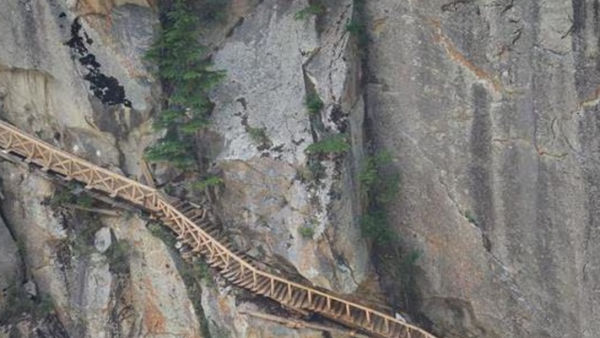
Gartang Gali, nestled in the picturesque Uttarkashi district of Uttarakhand, holds a captivating charm that beckons adventurers and history enthusiasts alike. This extraordinary place, known for its awe-inspiring beauty and rich cultural heritage, carries the echoes of a bygone era. The very existence of Gartang Gali is a testament to human perseverance and ingenuity, as it was carved out of the steep Himalayan hills by the Pathans of Peshawar and local residents in the 17th century. This treacherous path served as a lifeline for the villages of Nelang, Jadung, and Bhot, enabling the movement of goods and people through its 140-meter long wooden staircase. With its enthralling history as a witness to the Indo-Tibetan trade and its strategic location near the China border, Gartang Gali evokes a sense of wonder and offers a glimpse into the past. Exploring this fascinating place allows visitors to immerse themselves in its legends, relish the breathtaking landscapes, and appreciate the resilience of those who traversed this remarkable path.

History
During the 17th century, the Pathans of Peshawar, in collaboration with local residents, undertook the formidable task of carving a treacherous path through the steep Himalayan hills. This path was created to facilitate the movement of villages in the Nelang, Jadung, and Bhot areas of the Jad Ganga valley, situated at an elevation of 11,000 feet above sea level in the Uttarkashi district. The visionary behind this endeavor was Seth Dhaniram ji, a resident of the village of Nelong at that time.
The resulting 140-meter long wooden staircase, known as Gartangali, holds a significant place in the history of Indo-Tibetan trade. Before 1962, Indo-Tibetan traders and residents of the villages of Jadung and Nelang used to traverse this perilous route, relying on yaks, horse-mules, and sheep to transport their goods. Even the army utilized this route for a decade following the Indo-China war.
However, over the past 40 years, the non-use and lack of maintenance of Gartangali have caused its gradual disappearance, eroding its existence as a witness to the vibrant trade between India and Tibet. The Nelong valley in Uttarkashi district, located near the China border, holds strategic significance, leading to its designation as an Inner Line Area. The army maintains strict vigilance, and permission is required to access the area.
Yet, in the past, the Nelong valley thrived with Indo-Tibetan merchants. Dorji, the Tibetan merchants, used to journey to Uttarkashi via Gartangali, Sumla, Mandi, and Nelong, transporting wool, leather clothes, and salt. Uttarkashi was renowned for its bustling market, known as "Badahat" or the big market, where these goods were traded. Dorji would then return with items like oil, spices, pulses, jaggery, and tobacco.
The historical significance of Gartangali and its association with the Indo-Tibetan trade offers a glimpse into the vibrant past of the region. Although its existence may be fading, the stories of the daring pathmakers and the bustling trade that once thrived in the Nelong valley continue to evoke a sense of awe and admiration.
What to Expect
When visiting Gartang Gali, there are several things to expect that contribute to the unique experience of this historical and scenic destination:


The Gartang Gali trek offers an exhilarating adventure through the rugged Himalayan terrain, providing an opportunity to experience the historical significance and natural beauty of the region. Here's a sample itinerary for the Gartang Gali trek:
Day 1: Arrival in Uttarkashi
Day 2: Uttarkashi to Nelong Valley
Day 3: Trek to Gartang Gali
Day 4: Explore Gartang Gali and Return
Please note that this is a sample itinerary and can be customized according to your preferences and the availability of time. It's essential to consult with a local trekking agency or guide for the most accurate and up-to-date information on the Gartang Gali trek, including necessary permits, safety precautions, and recommended trekking seasons.
Distance from Delhi and How to Reach
The distance between Delhi and Gartang Gali in Uttarakhand is approximately 448 kilometers (278 miles) via road. The nearest major city to Gartang Gali is Uttarkashi.
Here are a few options on how to reach Gartang Gali from Delhi:
Please note that the route from Uttarkashi to Gartang Gali involves trekking and may require the assistance of a local guide or trekking agency. It's advisable to make prior arrangements and gather all necessary information regarding permits, accommodation, and safety guidelines before embarking on the journey.

Best Time to Visit
The best time to visit Gartang Gali is during the summer and autumn months, from April to November. This period offers favorable weather conditions for trekking and allows you to enjoy the stunning beauty of the Himalayas and the surrounding landscapes to the fullest. The weather during these months is generally pleasant, with clear skies and mild temperatures, making it ideal for outdoor activities. However, it's important to note that the weather in the mountains can be unpredictable, and it's advisable to check the local weather forecast and consult with trekking experts before planning your visit. Additionally, it's recommended to avoid the monsoon season (July to September) due to heavy rainfall and the potential for landslides, which can make the trekking routes challenging and unsafe.